|
 |
 |
 |
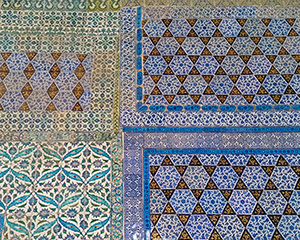 |
|
Istanbul, Turkey The Kiosk across from Gulhane Park (across from the Park gate, or the Soğukçeşme Kapısı), which people pass as they approach the Topkapı Palace entrance. The kiosk is actually the Abdülhamit I Sebili [a place for dispensing water] built for that Sultan (Abdülhamit I) by the architect Mehmet Tahir Ağa in 1777 or 1778, and moved here to be near the cemetery of the Zeynep Sultan Mosque in the 1950s.
土耳其-伊斯坦堡 |
Middle gate (Orta Kapı) in Topkapı Palace, the way to go from the First Court into the Second Court. It was known as the Gate of Greeting or the Gate of Peace. It probably dates back to the time of Mehmet II (ruled 1451-1481 and conquered Constantinople in 1453). Süleyman I provided a new iron doors around 1524 or 1525. Mahmut II (ruled 1808-1839) has his monogram (his tuğra) above the middle of the entry, and above that is calligraphy that proclaims “There is no god but God, and Muhammed is the Apostle of God.” The gate looks defensive, but it was used as a prison, and not really a military part of the palace defenses. (托普卡比宮) |
Decorative tiles over the door to the Circumcision Room. The Circumcision Room may have been where the princes were circumsized, or where they came to be entertained (distracted from their pain?) after the circumcision. It is also possible that this room was mainly used by sultans for their prayers. |
Panels of tiles on the Circumcision Kiosk. The blue tiles that have been painted with gold (the hexagon tile pattern) are similar to some tiles in the Tile Kiosk (part of the Archeology Museum) and some Ottoman structures in Bursa, and so, according to Dr. Fanny Davis (see page 158 of her excellent The Palace of Topkapı in Istanbul, 1970) these date to the 15th century. The tiles on the left side of this image are from the 17th century, about 150 years more recent. |
|
 |
 |
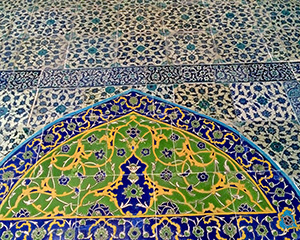 |
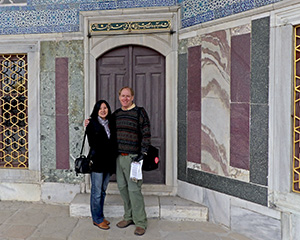 |
|
These panels to the right of the door into the circumcision room (exterior) include the lovely single panel of blue gazelles, leaves, flowers, and birds on a white background, and the white and red flowers on a blue background, matched by a panel at the entrance to the privy chamber of Ahme I and peacock panel in the Pavilion of hte Holy Mantle. |
This image shows some details of those tall (5-and-a-half feet) single ceramic panels with the blue flowers and leaves on the white background. An artist (Shah Kulu or Shah Quli) seems to have drawn these images (or images quite similar) in an album for Murat III in 1575, so these may also date back to that era. These are on the exterior of the Circumcision Room |
Example of tiles inside the Circumcision Room. This building was constructed during the rule of Süleyman I (ruled 1520-1566) as a summer kiosk, but as some tiles on it date to the 1600s, it is clear that it was remodeled somewhat in later years. The room was also used for the circumcision ceremony for the princes of Sultan Ahmet III (1703-1730). |
Jeri (彭春枝) and Eric pose for a photograph outside the Baghdad Kiosk. We are the two photographers who took almost all the photographs on this page, although our son Arthur also took some photographs, including this one of course. |
|
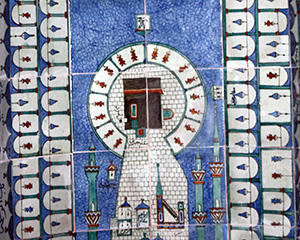 |
 |
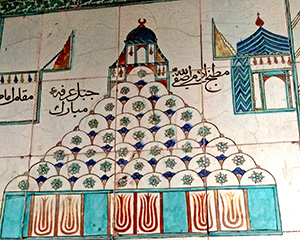 |
 |
|
Tiles in the Harem showing the Ka'bah in Mecca. In several rooms there are tiles depicting holy sites and places. |
Tiles showing holy places |
Panel of tiles in the Goldren Road passage in the Harem. It is similar to the tiles shown on the image to the left. |
Minaret and chimney over the Harem. There are many of these little minarets and chimneys all over the Harem. |
|
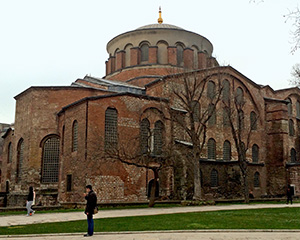 |
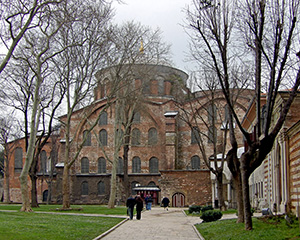 |
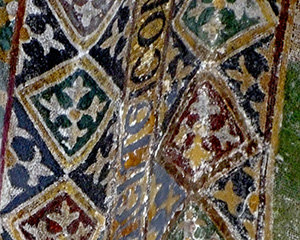 |
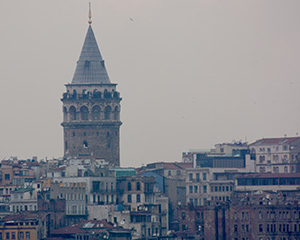 |
|
The Church of Hagia Eirene stands in the first courtyard of the Topkapı Palace, but it is of course much, much older than the rest of the palace. |
The Church of Holy Peace or Saint Irene was built in the 6th century (perhaps initially built as early as the 4th century), but earthquakes damaged it and it was rebuilt or repaired several times. The Ottoman government used this as an arsenal, and it was the site of the Turkish Military Museum in the 20th century. |
Detail of decorations in Saint Irene Church. It is difficult to distinguish between the older mosaics and the newer ones added during renovations or repairs over the centuries, but some of the decorative work in the church must date back to the 8th century. |
Galata Tower was built by the Genoese in 1348, as the Byzantine government was at that time quite friendly with the Genoese trade and naval empire that dominated the Mediterranean Sea. This is the view of it looking out from the Topkapı Palace. |
|
 |
 |
 |
 |
|
Colonnade around the Third Court in the Topkapı Palace |
Tower of Justice. The Tower of Justice is old, dating back to the years shortly after the conquest of Constantinople, but the top of the tower shown in this photograph was imposed on the palace by the horrible Sultan Abdülaziz (1861-76). |
One of the many minarets in the Topkapı Palace |
Galata Tower |
|
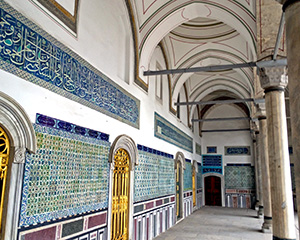 |
 |
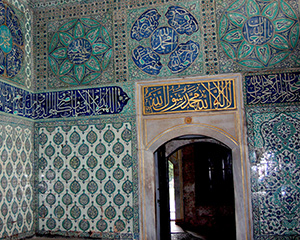 |
 |
|
Corridor with Pillars with the Pavilion of the Blessed Mantle on the left |
Guard Room decoration in tiles with the theme of the tree of life. |
Guard Room, the second room one enters when coming into the harem from the Second Court. Also known as the Place of Attendants at the Tower Door. This is looking back out toward the Second Court. |
A closer look at some the details of the tiles in the Place of Attendants at the Tower Door (the guard room). From this room are doors to the Mosque of the Black Eunuchs, and also a platform for the Sultan to help mount a horse. |
|
 |
 |
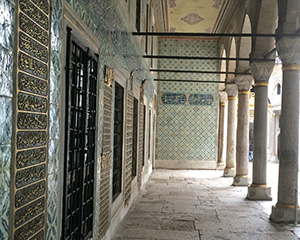 |
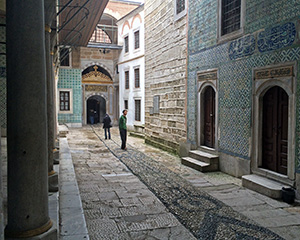 |
|
Coming out of the Guard Room, one enters the open Courtyard of the Black Eunuchs, and to the right on sees these doors to the apartment of the Black Eunuch Treasurer. |
Courtyard of Black Eunuchs, looking back toward the Place of the Attendants at the Tower Door. The Courtyard is open in the middle, but includes a portion that has a roof and dome over it. |
Porch of Black Eunuchs’ Dormitory, which is one side of the Courtyard of the Black Eunuchs. |
Courtyard of Black Eunuchs, looking from the Porch of the Black Eunuchs’ Dormitory toward the Main Harem Door. |
|
 |
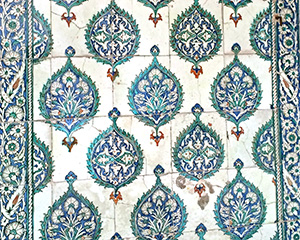 |
 |
 |
|
Admire some of the tiles in the harem. |
Take a closer look at these tiles in the harem. |
These tiles are in an area near the main door to the harem and the Black Eunuchs’ quarters |
There are several plaques in the Courtyard of the Black Eunuchs, like this one on the Dormitory of the Black Eunuchs. |
|
 |
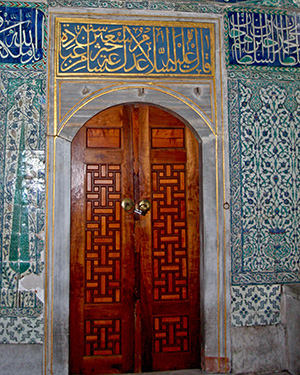 |
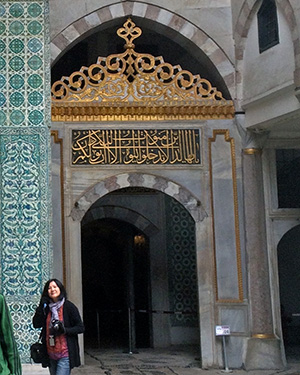 |
 |
|
This door is inside the Sofa Kiosk, also known as the Mustafa Pasha Kiosk, also known as the Kiosk on the Terrace. This is the kiosk out in the Fourth Court, and not in the harem. |
In the Place of the Attendants at the Tower Door (the guard room before one enters the courtyard of the Black Eunuchs) one can see this locked door, which evidently leads to the tower. |
Here is the main entry to the Harem (from the Courtyard of the Black Eunuchs). |
Another example of calligraphy on a plaque in the quarters of the Black Eunuchs. |
|
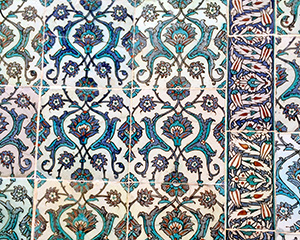 |
 |
 |
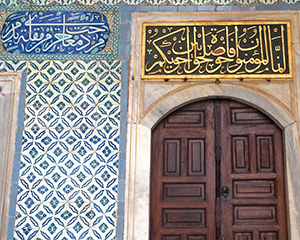 |
|
I liked these tiles in the harem. |
Here are some 17th century tiles with wonderful calligraphy |
Calligraphic inscriptions are found all over inside the Topkapı Palace. |
More examples of calligraphy in the harem. |
|
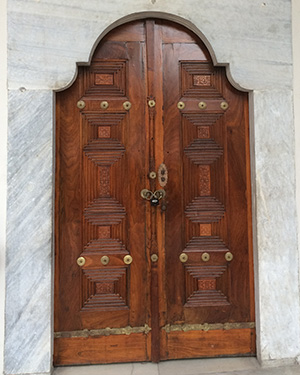 |
 |
 |
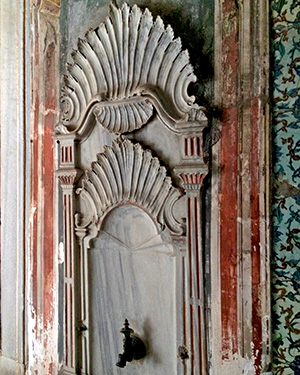 |
|
Here is a door in the Third Court |
This is the gate to the Imperial Mint, out in the First Court, near the Hagia Eirene. |
Many of the locked doors in the palace are just closet doors. |
Many rooms around the palace and in the harem have fountains. |
|
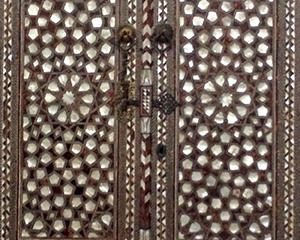 |
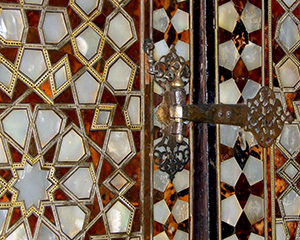 |
 |
 |
|
Mother-of-Pearl inlay with wood. This is seen in some doors and window shutters. |
A close-up look at some inlay we noticed inside the Double Kiosk (in the harem) |
More of the mother-of-pearl inlay. |
Dominant tiles colors are blue, turquoise, white, and green, but some yellows and reds appear as well. |
|
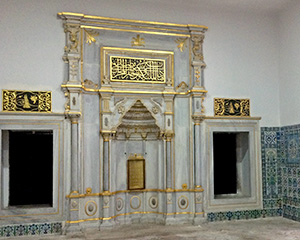 |
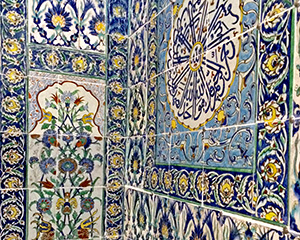 |
 |
 |
|
This is the Mihrab in the harem mosque. |
Some of better tiles are in the harem mosque. |
Tiles in the harem mosque. |
Windows with this sort of wooden lattice screen protected the privacy of those inside. |
|
 |
 |
 |
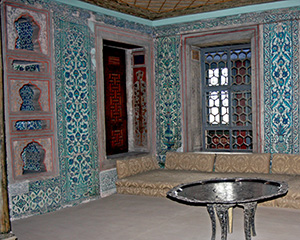 |
|
The palace offers visitors who enjoy ceramic tiles an enjoyable opportunity to see a variety of styles. |
Tiles in the harem. |
The mother of the Sultan (the Sultan Valide) was sometimes the de facto ruler of the Ottoman empire, and she had a suite of rooms in the harem. |
Sometimes the Mother Queen (Sultan Valide) at her meals in this area, and sometime some of the Queen Valides may have slept in this area. |
|
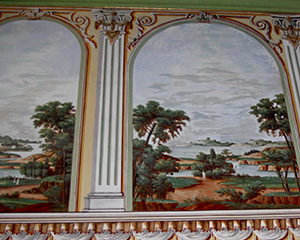 |
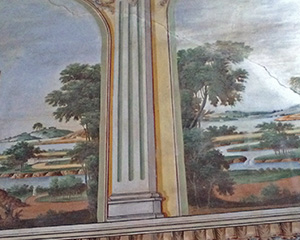 |
 |
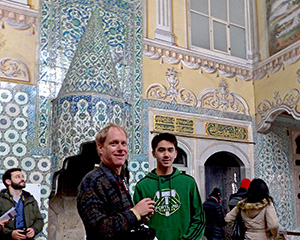 |
|
In the 18th century these landscape murals were added in one of the rooms of the Queen Valide. The most famous and powerful Queen Valides had lived generations before this in the 17th century. |
Another view of the wall in the Queen Mother’s Apartment. |
A wall in the Queen Mother’s Apartment (The Valide Sultan), with the fireplace. |
Eric and Arthur in one of the rooms of the Queen. |
|
 |
 |
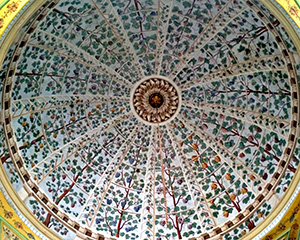 |
 |
|
In a room for the Sultan’s mother. |
Another view of the a room for the Sultan’s mother. |
Looking up at the dome in one of the apartments of the Sultan’s mother. |
The dome of the Sultan’s mother’s room. |
|
 |
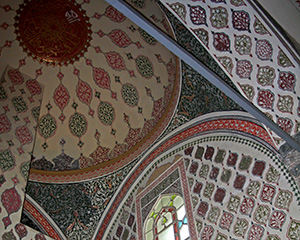 |
 |
 |
|
A little room with musical instruments. |
This passage near the Room with the Fountain and the Bedroom for Murat III is a place visitors pass through after going from the Hall of the Sultan. I think it is the vestibule of the bedroom of Murat III. |
Departing the Hall of the Sultan, visitors may walk through the Room with the Fountain, and this is the calligraphic inscription above the fountain. |
A unique inlay decoration near the Twin Kiosk in the harem. |
|
 |
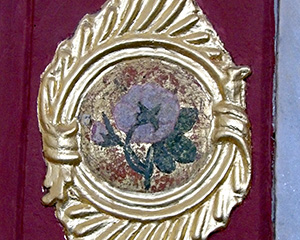 |
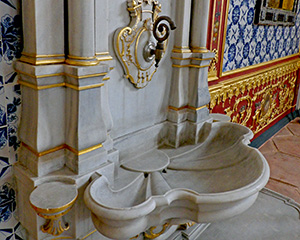 |
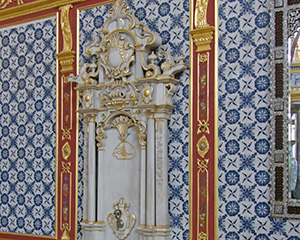 |
|
Door in the Imperial Hall, or the Hall of the Sultan. |
Detail of a flower decoration on a door in the Hall of the Sultan |
Fountain in the Hall of the Sultan. |
Fountain in the Hall of the Sultan. There are three like this in the room. |
|
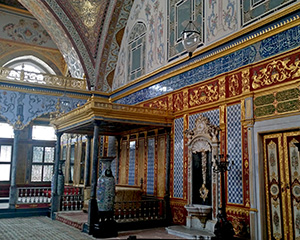 |
 |
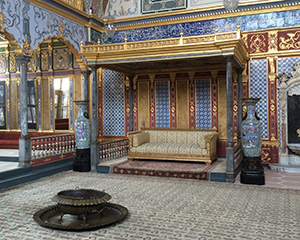 |
 |
|
The Hall of the Sultan. The balcony is where musicians might perform. |
The sultan’s sofa in the Hall of the Sultan. |
The Hall of the Sultan (the Imperial Hall) is the largest room in the harem. |
The sultan could enjoy plays and concerts and dances in this large room. |
|
 |
 |
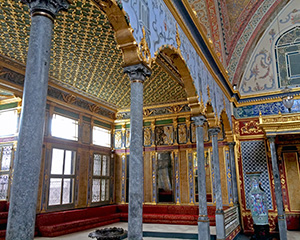 |
 |
|
The dome in the Hall of the Sultan. |
Detail of the decorative frieze around the wall in the Hall of the Sultan. |
The raised portion in the Hall of the Sultan, where women of the Harem might attend. |
Looking over the railing into the raised area of the Hall of the Sultan. |
|
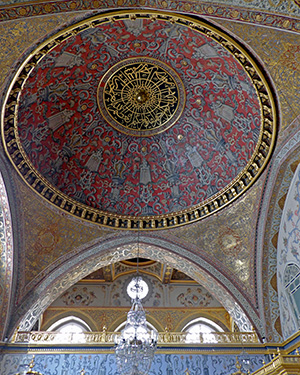 |
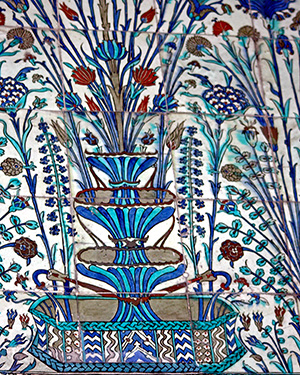 |
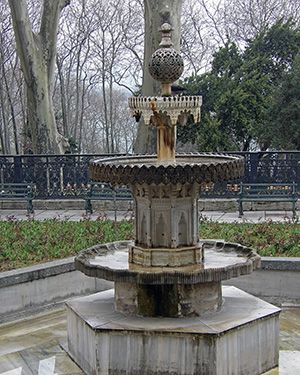 |
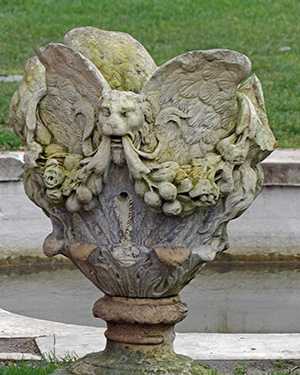 |
|
Another view looking up in the Hall of the Sultan. |
Tiles in the Twin Kiosk. |
The tiered marble fountain near the Baghdad Pavilion in what was once the tulip garden. |
A fountain by the pool in the lower gardens just below the Baghdad Pavilion in the Fourth Court. |
|
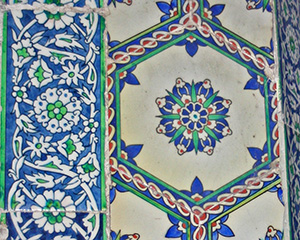 |
 |
 |
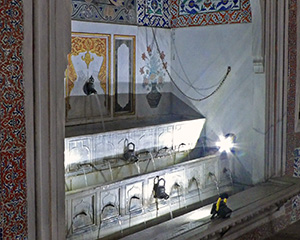 |
|
Example of hexagonal tiles. |
Another example of hexagonal tiles. |
A panel of hexagonal tiles. |
The recessed marble fountain with tiers of water in the bedroom of Murat III. |
|
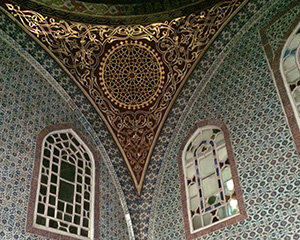 |
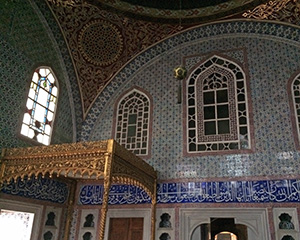 |
 |
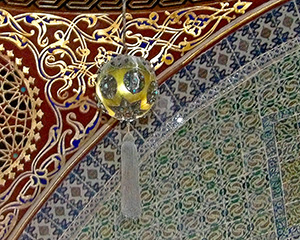 |
|
Privy Chamber of Murat III (his bedroom) |
Privy Chamber of Murat III (his bedroom) |
Dome in bedroom of Murat III (ruled 1574-1595) |
Hanging ornament in bedroom of Murat III |
|
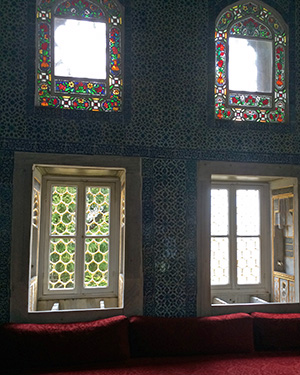 |
 |
 |
 |
|
Inside the Circumcision Room |
Window in the Circumcision Room |
Detail of window in the Twin Kiosk (or Double Kiosk). This is an upper window in the room that has the dome. |
This is a close-up of the window in the vestibule of the bedroom of Murat III. |
|
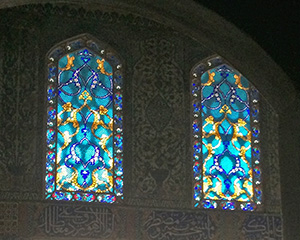 |
 |
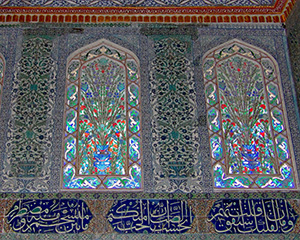 |
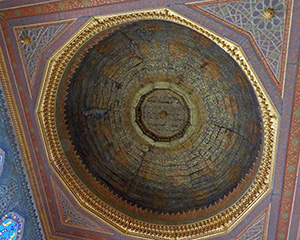 |
|
Windows in the domed room in the Twin Kiosk. |
Inside the Twin Kiosk in the room with the flat ceiling. |
Windows and tiles in Double Kiosk (Place of Boxwood), probably dating to the period of Mehmet III (1595-1603). |
Dome in the Twin Kiosk, in the room that is sometimes called the mirrored room. |
|
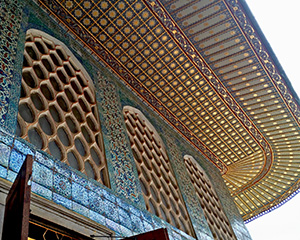 |
 |
 |
 |
|
Exterior of the Twin Kiosk |
Exterior of the Twin Kiosk and Bedroom of Murat III, and the full image also shows the marble pool down below. This is the view from the courtyard of the favorites. |
Exterior of the Twin Kiosk |
Exterior of the Twin Kiosk looking into the Courtyard of the Favorites (the Gözdes) |
|
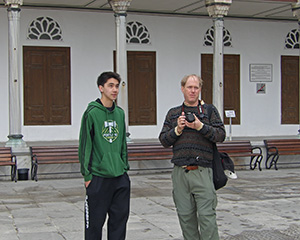 |
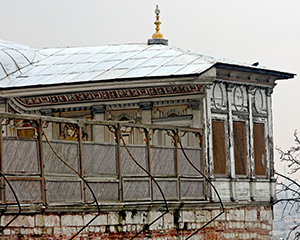 |
 |
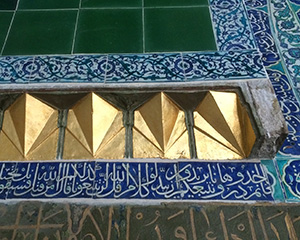 |
|
Arthur and Eric standing in the Courtyard of the Gözdes |
The Kiosk of Osman III (ruled 1754-1757) |
Privy Chamber (bedroom) of Ahmet I (ruled 1603-1617). |
Detail in Privy Chamber of Ahmet I |
|
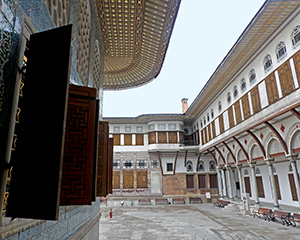 |
 |
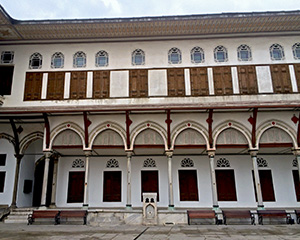 |
 |
|
Courtyard of the Gözdes, looking down toward the Mabeyn with the Twin Kiosk to the left and the apartments of the favorites (the Gözdes) to the right. |
The Mabeyn seen from the courtyard of the Gözdes. |
Courtyard of the Gözdes. |
Soffit on the eaves of Mabeyn seen by looking up from the Courtyard of the Gözdes. |
|
 |
 |
 |
 |
|
Jewels encrusted with gems on embroidery. |
Beads and embroidery. |
A bowl for stewed fruit. |
A Chinese plate exported to the Ottomans, dating to the mid 14th century. |
|
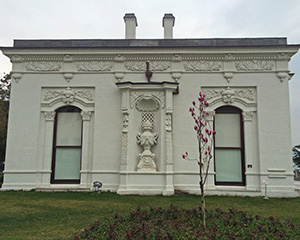 |
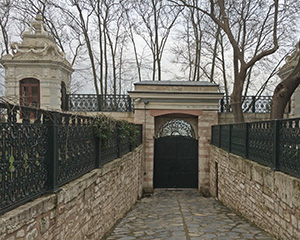 |
 |
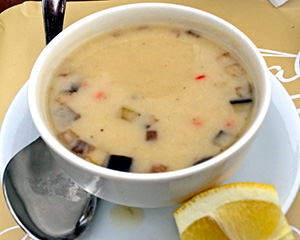 |
|
The exterior of the Mecidiye Kiosk, which stands in the fourth court, and is the location of the restaurant. This was constructed in 1859-1860. This is where sultans would stay when they visited Topkapi after moving to the newer modern palaces in other parts of Istanbul. |
Looking down the ramp from the Physician’s kiosk toward the Third Gate of Topkapi Palace. |
Lunch in the Topkapi Palace of the Ottoman Sultans. Now that it is a museum, there are restaurants and snack shops to please visitors who become hungry. |
A soup served in the palace to visitors who may need a break to think about what they have seen before continuing their inspection of the kiosks and contents of the museum. |
|
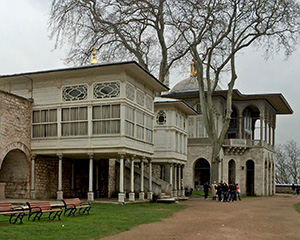 |
 |
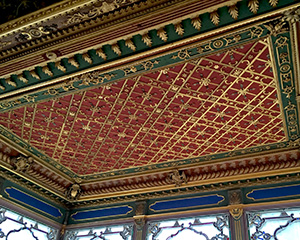 |
 |
|
Looking along the lower part of the Fourth Court with the very old defensive wall, the Sofa Kiosk (Kiosk on the Terrace), and the Baghdad Kiosk lined up as one looks toward Istanbul. |
Ceiling in one of the rooms in the Kiosk on the Terrace. This place is also known as the Kara Mustafa Pasha Pavilion, and the Top of the Stairs Pavilion, and the Sofa Pavilion. |
Another ceiling in another room within the Kiosk on the Terrace. These rooms were renovated in 1753, but the building probably dates back to the 17th century. |
The Sofa Pavilion has two main rooms: the Sherbet Room and the Divan-Lounge Room. I am guessing that this is the Divan-Lounge Room. |
|
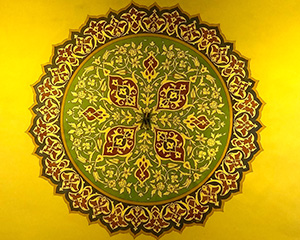 |
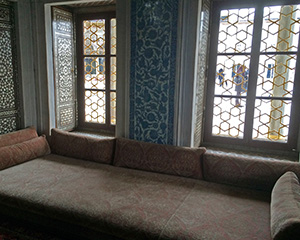 |
 |
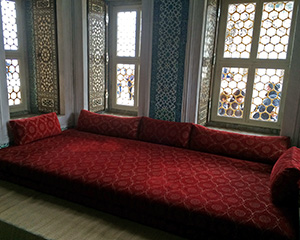 |
|
A painted ceiling in Topkapi Palace |
Interior of Baghdad Kiosk |
Interior of Baghdad Kiosk |
Interior of Baghdad Kiosk |
|
 |
 |
 |
 |
|
Dome ceiling in Baghdad Kiosk. The Baghdad Kiosk was built in 1639. |
Looking up at the Baghdad Kiosk from the lower garden area of the Fourth Court |
Windows inside the Baghdad Kiosk. |
Tiered marble fountain in the former tulip garden and the Baghdad Kiosk behind it. |
|
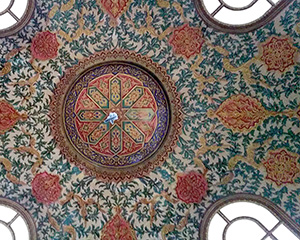 |
 |
 |
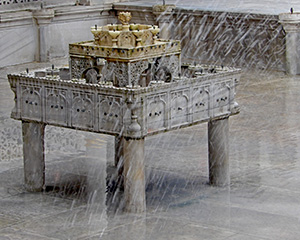 |
|
Looking up at the ceiling dome of the Revan Kiosk (built in 1635) |
Looking up at the Revan Kiosk. |
View from the entrance to the Revan Kiosk looking across the marble terrace and the pool with the square fountain toward the Circumcision Room and the Corridor with Pillars. |
The square marble fountain in the marble pool just outside the Revan Kiosk. |
|
 |
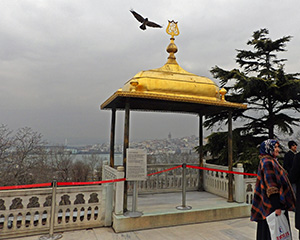 |
 |
 |
|
The Iftaree Pavilion, where the sultans could break their fast at sunset on evenings during Ramadan. |
The Iftaree Pavilion was built during the rule of Sultan Ibrahim (1640-1648), and offers a great view of the Golden Horn and Galata. |
Exterior of dome over Bâbü's-saade (Gate of Felicity), the point between the Second Court and the Third Court (the Inner Court). |
Parrots in the courtyard of Topkapi Palace. |
|
|
Other web pages with our pictures:
2015 collection of images from Europe
- Page 1, London.
- Page 2, Castille: Madrid
- Page 3, Strasbourg in March.
- Page 4, Strasbourg in April.
- Page 5, Strasbourg in May.
- Page 6, Paris.
- Page 7, The interior of the Notre Dame Cathedral in Strasbourg.
- Page 8, The exterior Strasbourg Cathedral in Strasbourg
- Page 9, Turkey: Edirne and Istanbul.
- Page 10, Austria: Salzburg.
- Page 11, Switzerland: Basel, Gimmelwald, & the Alps.
- Page 12, France: Alsace and Lorraine (Nancy, Colmar, Haut-Koenigsbourg, Obernai, Molsheim, Nideck, Haguenau)
- Page 13, France and Monaco (Nice, Saint-Jean-Cap-Ferrat, Montpellier, Monte Carlo)
- Page 14, Germany: Bavaria (Füssen, Hohenschwangau, Munich)
- Page 15, Germany along the Rhine (Rastatt, Karlsruhe, Bruchsal, the Rhineland-Palatinate)
- Page 16, Bulgaria (Varna, Plovdiv, Kazanlak)
- Page 17, Romania (Brasov, Bran, Sinaia, Sighisoara, Biertan, Sibiu, Bucharest)
- Page 18, Luxembourg and Arlon, Belgium
- Page 19, Italy and San Marino (Milan, Genoa, Bologna, Rimini, Citta di San Marino)
- Page 20, Catalan: Barcelona
- Page 21, Netherlands: Amsterdam
- Page 22, Denmark: Copenhagen
Thematic Pages
- Page 1, Doors (1): Doors and portals.
- Page 2, Doors (2): More doors, portals, and gateways.
- Page 3, Doors (3): More gates, doors, portals, and entrances.
- Page 4, Doors (4): Even more doors.
- Page 5, Door Fixtures (1): Decorations and fixtures on doors; door knockers or door knobs.
- Page 6, Door Fixtures (2): More door handles, door knobs, knockers, and so forth.
- Page 7, Door Fixtures (3): Another page of door fixtures such as door knobs.
- Page 8, Lamps and Lights (1): Lanterns and lamps, with several from Romania.
- Page 9, Lamps and Lights (2): Lanterns and lamps, including San Marino and Barcelona.
- Page 10, Lamps and Lights (3): More lanterns and lamps.
- Page 11, Lamps and Lights (4): Even more lights, lanterns, lamps, and so forth.
- Page 12, Flowers, Tulips (1): Keukenhof Garden and its tulips..
- Page 13, Flowers, Tulips (2): Second page of flowers, more tulips in Keukenhof Garden.
- Page 14, Flowers, Tulips (3): More tulips.
- Page 15, Flowers, Orchids (1): Flowers, mostly orchids.
- Page 16, Flowers, Orchids (2): Orchids and similar flowers.
- Page 17, Flowers, Orchids (3): Even more orchids.
- Page 18, Flowers and Plants (1): Various plants, including flowers and trees.
- Page 19, Flowers and Plants (2): Flowers and interesting trees, and also mushrooms.
- Page 20, Flowers and Plants (3): Trees, flowers,ferns, and interesting plants.
- Page 21, Spires and Weathervanes (1): Weather vanes and decorative spires on top of roofs.
- Page 22, Spires and Weathervanes (2): More weathervanes, spires, and so forth.
- Page 23, Spires and Weathervanes (3): Even more decorative spires and weathervanes.
- Page 24, Shop Signs and Ornamental Ironwork (1): Fences, gates, shop signs, and so forth.
- Page 25, Shop Signs and Ornamental Ironwork (2): More shop signs and ornamental iron.
- Page 26, Domes (1): Views of round roofs and cupolas, including large domes.
- This is page 27, Domes (2): Views of domes and cupolas, including some spires, interior and exterior.
- Page 28, Windows (1): A page of interesting windows.
- Page 29, Windows (2): Another page showing windows.
- Page 30, Windows (3): A page of windows, mostly stained glass windows.
- Page 31, Windows (4): More windows.
- Page 32, Jewels and Ornaments (1): Jewels and ornaments.
- Page 33, Jewels and Ornaments (2): More jewels and ornaments and decorative things.
- Page 34, Statues (1): A page full of picture of statues and sculptures.
- Page 35, Statues (2): More statues and sculptures.
- Page 36, Water features and water (1): Pools, ponds, lakes, rivers, waterfalls, and so forth.
- Page 37, Water features and water (2): Beaches, lakes, rivers, cascades, and so forth.
- Page 38, Faucets, Fountains, and Spigots (1): Mostly fountains.
- Page 39, Faucets, Fountains, and Spigots (2): Fountains and spigots or faucets.
- Page 40, Furniture (1): A page of interesting furniture.
- Page 41, Furniture (2): More examples of interesting furniture.
- Page 42, Palaces (1): A page with photos of palaces.
- Page 43, Palaces (2): More palaces.
- Page 44, Animals and zoos (1): Pictures of animals and scenes in zoos.
- Page 45, Animals and zoos (2): More images of animals and zoos.
History Timeline
Sources and diversions.

This work by Eric & Chun-Chih Hadley-Ives is licensed under a Creative Commons Attribution-NonCommercial-ShareAlike 4.0 International License. |
|












































































































































